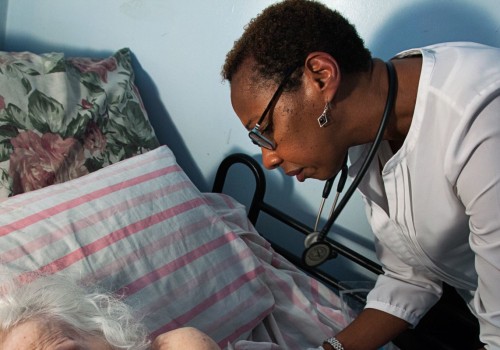Hospice care is for people nearing the end of life. Services are provided by a team of health professionals who maximize the comfort of a terminally ill person by reducing pain and addressing physical, psychological, social and spiritual needs. Palliative medicine is a medical subspecialty provided by doctors who offer palliative care to people who are seriously ill. Palliative care alleviates suffering and improves the quality of life of people of any age and at any stage of a serious illness, whether the disease is curable, chronic or life-threatening.
Palliative care is comprehensive care that relieves the symptoms of a disease or disorder, whether they can be cured or not. Hospice is a specific type of palliative care for people who are likely to have 6 months to live or less. In other words, hospice care is always palliative, but not all palliative care is hospice care. Palliative care is provided by an interdisciplinary team that may include a doctor who specializes in palliative medicine, a nurse, a pharmacist, a social worker, a dietitian, and volunteers.
Other doctors focus on your overall health or treating your illness or condition. Palliative doctors focus on preventing and alleviating suffering, improving your quality of life, and helping you and your loved ones cope with the stress and burden of your illness. But palliative physicians have special training and experience in pain management and symptom management, and they specialize in helping patients and their families cope with the many burdens of a serious illness, from the side effects of medical treatment to caregiver stress and fears about future. Palliative doctors can help you with difficult medical decisions, helping you weigh the pros and cons of various treatments.
Your palliative doctor coordinates care with your other doctors and helps you navigate the often complex health care system. Insurers and Medicaid agencies will provide coverage for hospice care if your doctors determine that you are likely to have 6 months (in some cases, a year) or less to live if your illness runs its normal course. However, it is your own decision to enter or leave hospice care. If your condition improves or if you want to seek curative treatment, you can leave hospice care and return if and when you want to.
You are eligible for hospice care if you are likely to have 6 months to live or less (some insurers or state Medicaid agencies cover hospice for a full year). Unfortunately, most people don't get palliative care until the last few weeks or even days of life, and months of useful care and quality time may be lost. The goal of palliative care is to make you feel comfortable and help you achieve the best possible quality of life. You can receive palliative care while undergoing treatments that can cure or reverse the effects of your illness.
In fact, palliative care can help you cope with aggressive treatments by managing pain and symptoms to help you fight the disease. Palliative care can be provided in a hospital, nursing home, assisted living facility, or at home. There are several ways to find a doctor who specializes in palliative medicine, such as asking your personal doctor to refer you to a palliative doctor or asking your local hospital if they have a palliative specialist. Addiction to prescription pain relief drugs is a common fear, but it doesn't happen often.
Palliative doctors are experts at preventing the problems and side effects of strong pain relievers. They can also help patients with addiction relieve pain. Properly Prescribed Drugs Won't Hasten Death. Your palliative doctor has the experience to design a drug plan that makes you feel comfortable and safe.
Palliative doctors care about you as a whole person, not just the part of you that is sick. They understand that people with serious illnesses can become frightened and unsure of themselves when making medical decisions. They also understand that there is not always a right or wrong answer and that their needs and wants may change over time. Palliative doctors consider all of this when they help you develop your treatment plan.
Many private insurance companies and health maintenance organizations (HMOs) offer hospice and palliative care benefits. Medicare (mostly for people age 65 and older) offers hospice benefits, and the Medicare Supplemental Plan (Part B) offers some palliative care benefits. Medicaid coverage for hospice and hospice for people with limited incomes varies by state. It's important to make a plan to live well.
Let us help you get started. For patients receiving hospice care in places other than their home, regular visits or 24-hour care may be options depending on the type of care environment, the patient's needs, and insurance coverage. Today, more than half of hospice patients have other conditions for which they are medically eligible for hospice services, such as advanced heart, lung or kidney disease, and advanced Alzheimer's disease or dementia. For patients receiving hospice care in a non-home setting, the primary caregiver is considered to be part of the palliative care team.
Contact your hospice team before receiving any of these services or you may have to pay the full cost. If your treatment no longer works and you run out of treatment options, you may want to ask your doctor or a member of your cancer care team about hospice. If you think your loved one and family might benefit from the support of weekly home visits by staff who specialize in pain management and distress relief, ask your doctor if hospice might be something you should consider now or in the near future. It's best to check with your insurance company because there are different types of plans available that may or may not cover hospice services.
Regularly scheduled meetings, often led by the hospice nurse or social worker, keep family members informed about their condition and what to expect. Temporary care can be provided for periods of up to 5 days, during which the person with cancer is cared for in the palliative care center or in beds reserved in nursing homes or hospitals. Hospice care is used when a disease, such as advanced cancer, reaches the point where treatment can no longer cure or control it. After 6 months, you can continue to receive hospice care as long as the hospice medical director or hospice doctor re-certifies (at a face-to-face meeting) that you are still terminally ill.
Not only are hospice services fully covered, but medical supplies and prescriptions related to pain management and comfort are also covered. You should ask the hospice what the role of your own doctor is once care begins and if the same nurse will visit you during the week. A person may exit the hospice program for a variety of reasons, such as resuming aggressive curative treatment or taking experimental measures. Instead, at Crossroads Hospice & Palliative Care, it's about celebrating the time the patient left and making them feel as comfortable as possible.
. .












